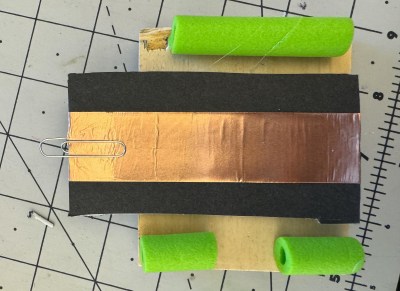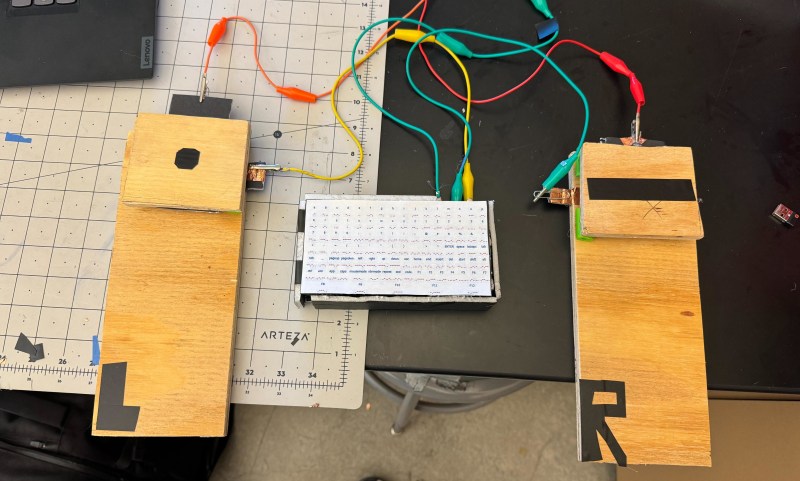What’s the worst thing about traditional Morse keyers? If you ask us, it’s the fact that you have to learn how to do two distinct things with one hand, and switch between them quite quickly and often.
 This set of Morse code foot pedals is meant for those who are unable to use traditional methods of keying. It uses a retrofitted wireless keyboard to read Z and X as dit and dah, respectively, and convert the Morse code into text.
This set of Morse code foot pedals is meant for those who are unable to use traditional methods of keying. It uses a retrofitted wireless keyboard to read Z and X as dit and dah, respectively, and convert the Morse code into text.
[Tevendale_Engineering] started by getting the controller out of the keyboard and figuring out which combination of pads sends Z and X. Then they wired those up with copper tape. The pedals themselves are made from 1/2″-thick wood, foam core board, and Nerf bullets to provide springiness.
There’s no solder here; it’s all copper tape and alligator clip test leads. So if this isn’t your hack for the day, we don’t know what is.
Not so great at Morse code? Here’s a clock that will train you on the numbers, at least.
















Why use the x and y keys when, you know, dot and dash are available? Also- keying in dots and dashes requires an”keyer” for a radio and involves timing and buffers and stuff. but who types out Morse? Is someone writing term papers like this? Or is this for someone with disabilities? And if so… look I have questions.
“Doing two things wit the same hand” doesn’t make sense either – paddles are, arguably, way easier than any other method. After no time at all
It is subconscious anyway like typing on an regular keyboard. This from a guy with a straight key and a bug.
The foot paddles themselves are indeed hack jobs though.
““Doing two things wit the same hand” doesn’t make sense either – paddles are, arguably, way easier than any other method.”
I’d like to agree, but not all paddles are great. I’m thinking of those lightweight plastic paddles that are so common these days. They’re ugly.
Classics like, say, the ETM-3 or HD1410 are heavy and don’t move away.
These elbugs also have a proper keyer built-in (TTL logic, no µC), which can be changed in speed.
Ok, they’re not complying to the newest dot/dash ratio algorithms, maybe.
But they’re dependable for what they are.
Using one hand to send Morse code is FAR more efficient than using two feet, and that is the case whether you use a paddle or a straight key. Fingers move faster and more controllably than feet. Other than not having either arm I don’t see where this makes much sense.
The feet method was actually in use, albeit with a single feet.
As a morse key, a switch for a sewing machine was used.
Btw, there’s also the Q code abbreviation “QLF”.
Some hams use it to say “are you keying with the left foot?”
It’s a joke, telling the other side that his/her telegraphy “handwriting” is poor.
I’m glad you mentioned this.
“Other than a perfectly good reason it doesn’t make sense” yes… good point… also: other than the existence of electricity my laptop is useless.
So if I manage to learn Morse, with this device I can be taught how to waltz by encoding what foot I must lift and move? Left Right, Left Right Right Left, Both!
Maybe. But your dance/music reference isn’t that far away from truth.
One method is to learn morse characters and Q codes as a melody, at a standardized speed.
Rather than separating them in dots and dashes and remembering the morse alphabet.
That’s why learning at slow speeds is making things unnecessarily hard.
It’s useless, too, because no one uses it practice. Experts struggle at slow morse, even.
Because, you must associate morse characters, not decode them. Thinking is out of place here, like it is with dancing.
And that’s exactly what happens with slow morse – you start to count (bad).
So better learn morse at 60 bpm (12 wpm if PARIS method is used?).
That way, you can also read morse ID of your local FM repeater (ham radio).
Alternatively, please do at least try to get 30-40 bpm going. That’s the lower limit your partner on the other end of the line can handle without pain. Vy73s/50s
I forgot to mention. It’s also helpful to learn morse with added pauses.
Back in the day, morse exams had used a faster speed, but with pauses between words or Q codes.
Also, 60 bpm isn’t as hard as it may seem at first glance.
Tempo 80 (80 bpm) is used on shortwave, for example.
The oldtimers use 120 bpm, even.
All good advice.
At this point why bother using Morse (only currently exists for hobbyists) if you’re going to turn it into something else anyway
Not sure what you mean by “turn it into something else”?
Cheesecake!
FYI. Learning Morse can roughly be broken down into the Farmsworth method (full speed ie 20-25 wpm) with extra space between characters or the Koch method- full speed everything starting with 2 characters then adding one at a time. All full speed.
This has been studied in detail during wartime when such things really mattered. The important thing is that characters be learned as sounds, not counting dot-dash which is useless for “practical” communication.
People that have learned these days say that learning slow then trying to go faster is useless. You just learn twice.
There is a ton of interesting history here.
This is great. Back before I knew about Morse code and barely knew about voltage let alone ohm’s law, I was busy taking things apart and seeing how they worked. Sometimes I was able to put them back together and they still worked. I remember doing projects like this just to see what would happen.
I once took an entire land line phone apart to build it into a headset with an old Walkman. I used an old Bic pen as the mic boom.
That’s the day I learned about the ring voltage on a telephone. Someone happened to call just as I was stripping the live telephone wire with my teeth.
I convinced my parents to take me to Radio Shack for some tools after that. But it’s what got me interested in electronics.
Most people would’ve stopped at taking it apart and playing around with the controller. He went the next step and did something useful.
Keep it up and let’s see where he goes next.